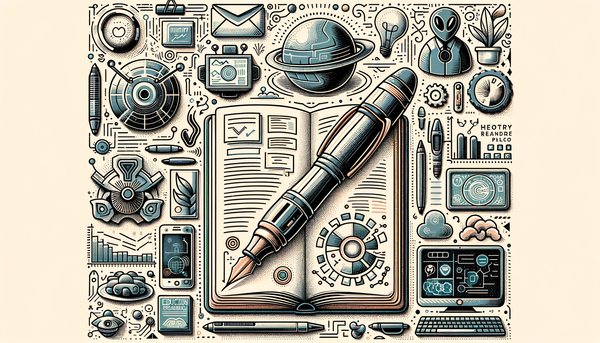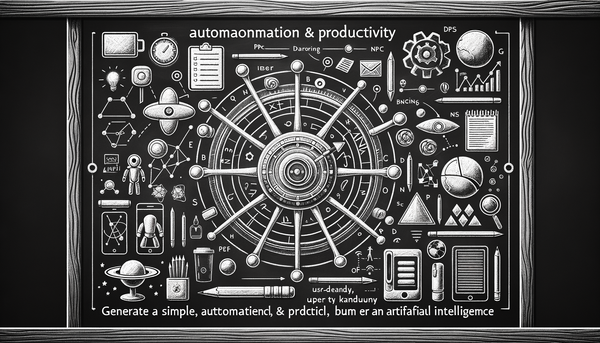AI News Update: Advancements and Collaborations in AI
A US education official’s humorous mispronunciation of AI as "A1" sets the stage for a sweeping transformation that is reshaping education, cybersecurity, workplace productivity, and even government services across the globe. This dynamic evolution, peppered with bold public–private collaborations and ambitious technological investments, signals both promise and challenge in embracing artificial intelligence for future growth.
Transforming Education through AI
The landscape of education in the United States is undergoing a seismic shift as policymakers champion the integration of AI into classrooms. Recent moves by key figures—ranging from the U.S. Education Secretary, who accidentally branded AI with an “A1” misstep as reported by PCMag, to the executive actions signed under President Trump’s directive featured on Mashable—highlight the urgency of embedding AI proficiency in K-12 learning environments.
These groundbreaking policies emphasize cultivating AI literacy at an early age, ensuring that today's students acquire the skills needed to navigate a future where machine intelligence is omnipresent. Initiatives include integrating AI-driven tutoring, automating administrative tasks, and offering personalized learning experiences that have already seen pilot success in institutions like Khan Academy. By fostering a deeper understanding of AI, the directive aspires to bridge the gap between traditional education and a tech-centric future.
This strategy does not only aim to enhance academic outcomes; it also serves as a reminder that education systems must evolve to prepare learners for industries where AI plays a pivotal role in innovation and problem solving. Educators are now encouraged to undertake specialized training to harness these new tools, a trend that will likely proliferate over the next several years.
Public–Private Collaborations: Government and Industry Join Forces
The integration of AI in public service is gaining momentum, evidenced by landmark partnerships such as the one between Alphabet and Palantir, as detailed on Yahoo Finance. This alliance aims to overhaul federal agency processes by merging Google Cloud’s robust infrastructure with Palantir’s seamless government software platform, FedStart. The synergy between these technology giants is poised to accelerate digital transformation in the public sector, enabling faster data analysis, more secure systems, and reduced bureaucratic red tape.
It is no coincidence that a similar spirit of innovation is sweeping across continents. In Europe, the JUPITER AI Factory—as covered by HPCwire—stands as an emblem of the EU’s quest to lay the groundwork for sustainable AI innovation. Leveraging Europe’s first exascale supercomputer, this initiative is central to training robust AI models in sectors like healthcare, finance, and energy. With ambitious plans to roll out 13 AI factories across Europe, policymakers are investing not just in technology, but in the human expertise required to govern it effectively.
Such projects illustrate the vital intersection of government strategy and corporate innovation. As highlighted in discussions on platforms like AI.Biz (AI Podcast Update on Innovations and Challenges), these initiatives broadcast a future where public–private collaborations become the norm rather than the exception. They not only promise advancements in service delivery and operational efficiency but also signal a concerted effort to align national technological ambitions with broader economic objectives.
Empowering the Modern Workplace with Multimodal AI
Beyond the realms of education and public service, artificial intelligence is revolutionizing workplaces with tools designed to simplify complexities and boost productivity. Atomicwork’s unveiling of its Universal Agent, reported on Morningstar, exemplifies this transformation. This multimodal AI tool integrates various data forms—text, voice, and visuals—into a single interface tailored for the unique demands of modern professional environments.
The Universal Agent is engineered to not only streamline everyday tasks but also foster a culture of technological empowerment among employees. By automating routine processes, it allows professionals to focus on creative and strategic endeavors, ultimately driving better business outcomes. This approach is an important antidote to the so-called “skills gap”, enabling workers to engage with sophisticated AI without the burden of a steep learning curve.
"Artificial intelligence is not a substitute for natural intelligence, but a powerful tool to augment human capabilities." – Fei-Fei Li
The implementation of such workplace solutions has profound implications for job satisfaction and organizational effectiveness. As employees benefit from AI-assisted workflows, the broader work environment transitions into one where innovation and efficiency go hand in hand, paving the way for more agile and resilient business models.
Innovations in Consumer Experiences and Digital Entertainment
Artificial intelligence is also leaving its mark on customer experience and entertainment. Spotify’s rollout of its AI-powered playlist feature, now available in over 40 new markets as noted by TechCrunch, is a prime example of how AI is personalizing media consumption. By allowing users to craft playlists using clever prompt phrases, Spotify is redefining how music is curated, blending genres and moods in ways that were once unimaginable.
This development not only augments the overall listening experience but also represents a broader shift in how digital services attract and engage customers. Personalized content is becoming a key differentiator as competition in the digital space intensifies. By leveraging advanced AI algorithms, companies can create deeply customized experiences that resonate with individual user preferences, leading to higher engagement and loyalty.
Just as AI is streamlining customer interactions on digital platforms, it is also transforming traditional customer service models. The recent collaboration between Omilia and Bell Integration, reported on Yahoo Finance, aims to revolutionize conversational customer service in the UK. The integration of generative AI technology with established IT systems promises to deliver omnichannel support that is both efficient and attuned to the nuances of human interaction.
AI in Cybersecurity: Navigating the Fine Line between Innovation and Risk
While AI continues to drive innovation, it also plays a dual role in the realm of cybersecurity. Research featured on TechRadar reveals that cybercriminal motivations have evolved from creating chaos to pursuing financial gain. Ransomware, data theft, and sophisticated phishing schemes have become increasingly prevalent, with cyber adversaries harnessing AI to execute more precise and highly coordinated attacks.
For industries such as finance, healthcare, and government, where the stakes are particularly high, these developments underscore the need for agile and adaptive defense strategies. In this rapidly evolving threat landscape, organizations must invest in advanced threat intelligence and cybersecurity measures to mitigate risks. AI, in this context, serves both as a powerful tool for defenders and, paradoxically, as an asset for attackers.
Investors and cybersecurity experts alike are closely monitoring these trends. Discussions in forums like AI.Biz provide regular updates and insights on how AI-driven cyber threats can be countered. The conversation is pivoting towards the importance of building systems that not only detect and respond to threats in real time but also anticipate them through predictive analytics and machine learning techniques.
Shifting Investment Trends in the AI Sector
Investment strategies in technology sectors are also being profoundly influenced by the rise of AI. For instance, concerns raised by Dan Niles, as covered on Yahoo Finance, regarding Microsoft's AI capex slowing down highlight critical challenges in sustaining high-growth investments. Despite substantial expenditures, the warning is clear: surging capex figures may not necessarily translate into long-term demand, urging investors to critically assess the market value of tech giants versus emerging AI ventures.
This viewpoint is reflective of broader market trends. With companies recalibrating their investment strategies and shifting focus towards efficient, revenue-generative models, there is an increasing appetite for tech firms that balance aggressive innovation with solid financial fundamentals. The discourse among investors encourages a measured approach—one that appreciates the potential of AI while remaining cautious of unsustainable hype.
In line with these developments, Databricks’ recent announcement to bolster hiring and invest $250 million in India, as reported by Reuters, serves as a testament to the global appetite for AI excellence. This significant investment is aimed at tapping into India’s vast talent pool and expanding the company’s AI capabilities, reinforcing the idea that robust AI strategies require not only technological innovation but also a deep commitment to nurturing human capital.
Collaborative Efforts Shaping the Future of AI Innovation
The discourse around AI is marked by collaborative endeavors that span industries and geographies. From government-led educational initiatives to strategic industry partnerships, the consensus is clear: collaboration is key to unlocking the full potential of artificial intelligence. For instance, Alphabet’s partnership with Palantir and the joint efforts of Omilia and Bell Integration demonstrate how cross-sector alliances can accelerate the deployment of innovative AI solutions across federal agencies and commercial enterprises alike.
Cross-referencing insights from earlier AI.Biz updates on innovations and industry insights, such partnerships reveal an underlying trend—a holistic approach to adoption where technology, policy, and consumer needs converge. Whether it is streamlining government operations or redefining customer experiences in interactive entertainment and support systems, these alliances are paving the way for a future where AI becomes an indispensable tool in everyday life.
This collaborative spirit is amplified by the global scale of investments and partnerships. The EU’s ambitious AI factories, Databricks’ expansion in India, and major tech companies recalibrating their capex strategies in line with economic realities all contribute to a vibrant ecosystem where innovation is practiced with an eye on both performance and sustainability.
A Glimpse into the Future: AI’s Expanding Horizons
As AI continues to evolve, its applications and implications are poised to extend into virtually every facet of our lives. Innovative products like Spotify’s AI-curated playlists not only enhance consumer engagement but also pave the way for a future where entertainment is fully personalized. Simultaneously, developments in cybersecurity and shifts in investment strategies signal an ecosystem that is learning to balance rapid technological change with the need for robust, resilient systems.
What remains particularly striking is the undeniable fact that AI is not developed in isolation. Its evolution is deeply intertwined with policy measures, educational reforms, and the private sector’s robust investment in research and development. From classroom reforms inspired by political directives to multi-billion-dollar investments in global tech hubs, the AI landscape is undergoing a metamorphosis that is as challenging as it is promising.
In the words of Michael Dell, "We are in the early days of an AI revolution. In the long run, AI will change the very nature of how humans work and interact with machines." These insights remind us that while the journey may be fraught with uncertainties and debates over ethics, strategy, and implementation, the potential rewards in terms of efficiency, innovation, and improved quality of life are immense.
Further Readings and Related Updates
- AI Podcast: Innovations and Challenges in Technology
- Exploring the Impact of AI Across Industries
- Overview of AI Innovations and Challenges
- Industry Insights: AI Innovations in Action
Embracing the pace of change and investments—as seen in strategic partnerships, government initiatives, and bold market moves—is now more than a trend. It's a testament to how AI is weaving itself into the fabric of society, promising not just innovation but a transformative realignment of our future.
Closing Reflections
While debates, cautious investment approaches, and a pronounced need for adaptable strategies persist, it is fascinating to witness such a confluence of ideas and initiatives. AI continues to inspire a blend of awe, innovation, and meticulous policy planning. The lesson from today’s unfolding story is clear: whether it be through education reforms, multinational partnerships, or new workplace tools, the AI journey is one of ongoing exploration and co-creation, urging us all to stay engaged, informed, and ready to innovate.



